You will need a chair or bench to perform this exercise. It is recommended to add weights after correct technique and adjustment of muscles to the load.

- What muscles work in the squat?
- What muscles are used in different squats?
- Mistake 1: Are my heels pulling off the floor?
- Mistake 2: Toes up?
- Wrong grip on the bar
- heels off the floor
- Don't pull your heels together. Errors when performing basic exercises
- lungs
- 5 reasons to include squats in your exercise routine
- What types of squats can you do?
- Don't be put off by problems with joint mobility
- Don't forget about the muscles of the posterior surface
- How to do squats correctly
- What the correct posture should look like
- Smith squats
- Squats with dumbbells/barbells
- safety principles
- Combine them with a series of core exercises
What muscles work in the squat?
What muscles are used when squatting? The squat is a compound exercise that uses free weights to engage the lower body. But it is precisely the squat that causes the most problems for beginners. The problem is that they have to be careful not to overload the knee joints and engage the right muscles that are supposed to be involved.
When it comes to squats, a distinction is made between deep and high squats, with your own weight and with a load. What are the main muscles that work in squats?
- The quads and quadriceps muscles are best exercised during squats. They are responsible for extending the legs at the knee.
- calf muscle. Keeps the body balanced, helps you stay upright and not fall backwards or forwards.
- Gluteus medius muscle and hamstrings. They regulate the extension of the legs; the hip joint is involved.
- The back muscles are involved. They are responsible for maintaining an upright posture.
- The abdominal muscles help maintain balance. Middle and lower body swings.
- thigh biceps.

Squats engage important muscles in the body, so they are equally beneficial for both men and women. Women especially like to incorporate squats into their workouts because they help them tone their legs, glutes, and back quickly. This simple exercise, if done correctly, can replace a complex in the gym. In addition, squats without weights are safer and healthier.
Before squatting, remember to warm up the affected muscles. A brisk walk on the treadmill or a light jog will suffice. Warming up helps prevent injury. It also prepares muscle tissue for work. Warming up the legs is important to increase blood circulation and better absorb the load.
What muscles are used in different squats?
What muscles are used when working with the body bar? If your goal is to build muscle mass and develop your quads and glutes, you should be working with weights. When working with a barbell or bodybal, your back needs to be straight and erect. Grasp the weight at shoulder height and your back should be straight. Your feet should be firmly on the ground, foot placement is important. Perform a classic squat and lift the weight overhead. Lower your thighs parallel to the floor. The body should neither lean forward nor backward as you return to the starting position.
If you want to work your leg muscles more, set them wider than you would for a regular squat. This way you can train the inner thighs. The outer part is trained more when the legs are close together. The barbell trains the quadriceps and glutes.
The plié squat works the inner thighs and glutes. This exercise is suitable for women who want to achieve beautiful sculpture of the legs and lower back. The further the legs stand, the more actively the muscles on the inner thighs are used. The pliés involve the waist, calf muscles and abs. These exercises not only train muscle groups, but also improve blood circulation in the pelvic organs, which is good for health. If dumbbells are used for this exercise, the back will work harder.

Sumo squats actively work the glutes and are a good exercise to pump up muscles and build mass. It's important not to round your back to reduce stress on your legs.
Mistake 1: Are my heels pulling off the floor?
Lifting your heels on a squat is a sign that your body - and with it the bar - is moving forward. You want to be as stable as possible during the squat, and if your heels lift off the floor, your stability is instantly gone. Ideally, the barbell should be supported by the whole foot and should be in line with the hip and ankle joints. As your center of gravity shifts forward relative to this vertical line, the risk of knee, hip, and lower back injury increases at lightning speed. And to be clear, pain from weight training isn't part of a weightlifter's trade. They are an unmistakable sign of poor movement technique.
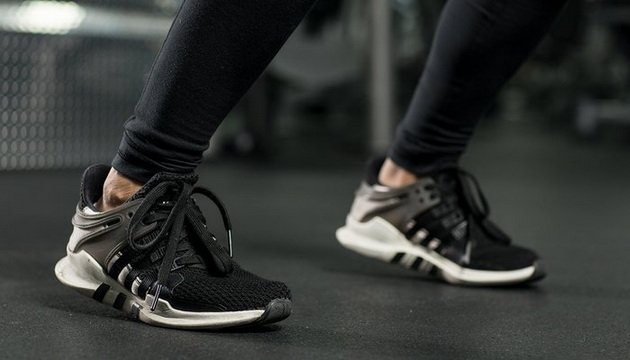
A quick way to correct a mistake is the 'tripod technique', in which you establish three points of contact between the foot and the ground: the heel, the inner and outer contact surfaces of the arch of the foot.
Point your toes and 'stick' to the ground with these three points to create a solid base from which to push off safely. If you can't keep your foot in constant contact with the ground, you run the risk of becoming a victim:
- Pain in the medial meniscus (inside of the knee).
- Hip impingement syndrome (pain in the groin and front of the hip).
- Pain in the lumbar spine.
These issues are constantly being discussed on powerlifting forums by athletes who don't know where the pain is coming from. Although many athletes don't consider this an 'injury' because there is no injury per se, that is what they are talking about. Injuries are not caused by an acute injury, but by systematic squatting with poor technique. They are easily avoided and usually treated effectively if the feet are properly planted on the ground.
Mistake 2: Toes up?
When the toes are off the ground, we have the opposite problem. With the toes off the ground, we shift the entire weight of the dumbbell to our heels. This overloads the posterior chain of muscles.
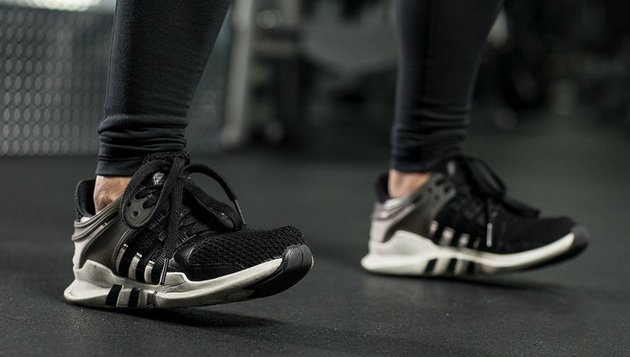
That's right: The posterior chain can become overloaded if you overload it every day — especially if you're doing the following exercises frequently:
- Classic squat (dominant load on heels).
- Romanian deadlift (heel predominance).
- Reverse lunges.
- Glute bridge with barbell.
- Superman exercise.
To correct the mistake of forefoot landing, use the tripod technique above and do toe bends with a towel to strengthen the foot muscles.
Wrong grip on the bar
Proper grip of the barbell is critical to the safety and comfort of the lifter. A grip that is too wide will prevent the lifter from controlling the bar. Too tight a grip puts extra strain on your elbows during the movement. Grasp the bar with your palm, not just your fingers. The optimal grip is 5-8 cm from shoulder width.
Be sure to pay attention to the position of the rod. If the bar is too high in the neck, you may experience pain in that area. This mistake also causes you to lose balance and involuntarily lean forward. The bar is best placed in the center of the trapezius muscle.
heels off the floor
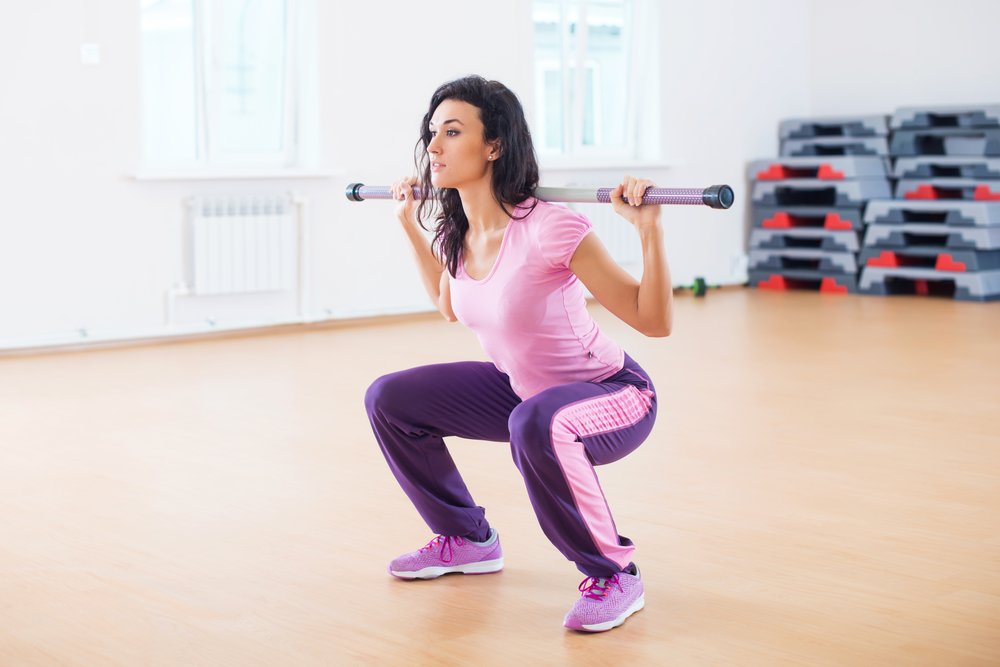
Keep your feet on the floor throughout the squat. Not having your heels on the ground can result in an imbalanced squat, which will negatively impact your technique, not to mention the possibility of injury. If you can't squat in a way that doesn't change the position of your feet during the movement, you need to work on your calf muscles. The stiffness of the lower leg muscles can cause the heels to lift off the ground. To loosen them up, just do a regular stretching exercise with occasional bends.
Don't pull your heels together. Errors when performing basic exercises

This exercise is a basic exercise that should not be missing in any workout. There are several common mistakes in technology.
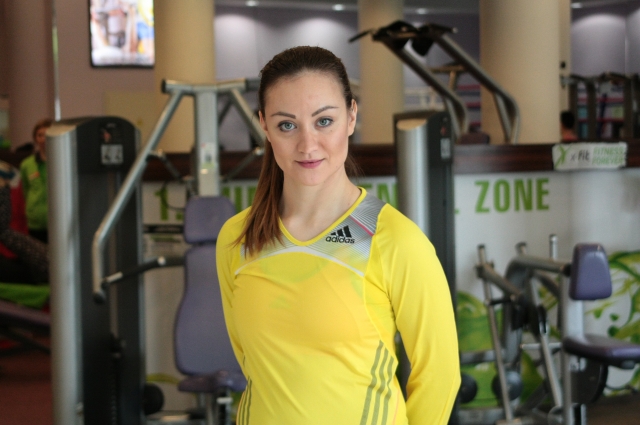
- The knees are extended beyond the toes. This movement can involve lifting the heels off the floor and is traumatic to the knee joint. While squatting, push your pelvis back and keep your knees above your ankles.
- Another common mistake when squatting is to move the knee joints in or out. Make sure that the knee joints move exactly towards the feet.
- Another dangerous mistake in squatting is the 'pelvic bend'. This means that the pelvis is twisted at the bottom of the movement and there is movement in the lower back. This is very dangerous for the back, especially when working with weights.
lungs
A mistake in this exercise also occurs if the movement mechanics in the knee joint are not correct. The front knee should not go past the ledge of the foot. You should also make sure that the front foot is pressed completely to the ground.
The plank is one of the most popular and technically difficult exercises. Unfortunately, most people perform them incorrectly and even at risk of injury.
- The most common mistake is insufficient tension in the cortical and gluteal muscles. This causes either the buttocks to sag or the pelvis to be elevated too high.
- A second important and common mistake is insufficient stabilization of the shoulder blades. This leads to an incorrect neutral position of the pectoralis major muscle and an excessive distribution of the load on the pectorals, deltoids and trapezius muscles.
Don't rush your workouts. Learn the right technique first - if you follow it, you can achieve your goals quickly and without risk of injury. Good luck with your training!
5 reasons to include squats in your exercise routine
If you want to tone your glutes, get rid of the 'halter' effect on your thighs and generally improve your appearance, running, Nordic walking or swimming is generally not enough. Add squats to your workout.
It's a myth that squats are bad for your knees. However, recent studies have confirmed the opposite. People who squat under the parallel have stronger knees because their strengthened peroneus muscles protect the ligaments from the extra stress.
Squats used to be considered bad for your knees: now that opinion has changed
If you run actively and regularly, you will develop muscular endurance but not muscular strength. The squat can do just that. What it is used for. To run faster on flat and hilly terrain, lengthen your strides, use oxygen more efficiently during exercise and reduce fatigue. With stronger legs, you'll find it easier to lose weight because you can increase the duration and intensity of your exercise.
If you've been dreaming of 'knuckles', nice abs and good posture for a long time, you should start with the squat. You activate your core muscles and abdominal muscles - even more than turning.
You can do squats anytime, anywhere - at home, on the gym, with or without weights. No special training or equipment is required. The exercise is so easy to understand and simple for everyone that it is suitable for young and old, beginners and professionals alike.
What types of squats can you do?
In reality, squats aren't as easy as they look. There are many variations of this strength exercise. Almost all are suitable for the prevention of osteoarthritis and injuries.
The decisive factor here is the number of repetitions. The goal is to strengthen muscles and increase endurance. If you work out in a gym, grab an empty barbell or work out with your own weight. Place the dumbbell on your thighs (not your neck or shoulders), feet shoulder-width apart, toes pointing out.
Squat down until your hips are parallel to the floor. Make sure your lower back and spine stay straight throughout the exercise and your knees don't reach to your toes. Start with three sets of 10 repetitions each.
You can do a basic squat with or without an empty bar.
Assume the traditional sumo position: spread your legs wide, toes pointing slightly outwards. Without lifting your heels off the floor, squat down so that your thighs are level with your knees. This exercise engages all of the muscles in your lower body, hamstrings, and calves. Using your own body weight, this is a sufficient load, so don't add dumbbells or barbells too quickly. Perform 10-12 repetitions in one approach.
In the video you will see how to properly perform sumo squats so that you will master the technique quickly:
This exercise works the quadriceps, biceps, hamstrings, abs, and gluteus maximus and medius. You can do them in place or in a lunge, with or without weights.
Stand with your feet shoulder-width apart and hold the dumbbells in your hands, or if you're working without weights, place your hands on your hips. Take a step forward and lower yourself so that your thigh is parallel to the floor. Keep the other leg behind you at a 90° angle. Push the front leg off the floor and return to the starting position. Perform 8-10 repetitions in one approach.
Don't be put off by problems with joint mobility
You've certainly been warned against squatting with a heel pad, as it elongates the knees beyond the imaginary plane passing through the toes.
The main reason for squatting on a heel pad (or small pancake) is that people lack the ankle flexibility to squat low enough without lifting their heels off the ground. They find a 'solution' by putting something under their heels to lift them off the ground. This eliminates the symptom, but does not solve the problem.
If you aim for high physical performance, you should ditch the heel brace and invest in a pair of quality powerlifting shoes. A raised heel increases the range of motion in the ankle, which increases the depth of the squat, allows the trunk to be more upright, and reduces tangential (tangentially directed) loading on the spine. Also, the powerlifting shoes have a stable heel that allows them to generate maximum power when pushing off the floor. This will make you stronger in the upward phase of the movement.
It is often said that pushing off the knees from the toe plane increases the tangential stress on the ligaments surrounding the knee joint. Over time, this can damage ligaments or worsen chronic knee problems.
This is exactly what happens when you squat on your heels - your knees are pushed forward and the pressure on them increases dramatically. This may not be a serious problem in the short term, but there is no guarantee that this practice will not result in knee injury or disease in the long term.
We often hear that hyperextending the knees beyond toe-level increases the tangential stress on the ligaments surrounding the knee joint.
Don't forget about the muscles of the posterior surface
Many people think that the hamstrings, which are formally a group of three muscles, don't need to be exercised because they're one of the most overlooked muscles. This strategy is a big mistake when it comes to keeping knee joints healthy.
Posterior surface muscle injuries are common. This is because the posterior surface muscles are weaker than the quadriceps muscles, which are their antagonists in the knee joint area. The pronounced muscular imbalance explains the high rate of cruciate ligament tears and rear dislocations. In women, the ratio of posterior chain strength to quadriceps strength is lower than in men. This ratio is even worse in female athletes, leaving them at higher risk of muscle strains or cruciate ligament damage.
To keep your joints strong and your knees healthy, you need to maintain a 3:2 balance between quadriceps and posterior chain strength.
To keep your joints strong and your knees healthy, you need a 3:2 balance of quadriceps and posterior surface muscle strength. An easy way to check is your 10 rep max (10RM) on leg curls with a weight that's at least 2/3 of your 10RM on leg extensions. For example, if your 10RM on leg extensions is 75kg, you should be able to do at least 10 squats of 50kg. If you're not able to do 10 reps in the squats, you're at serious risk of injury to your knees.
You may be under the impression that all of these squat exercises are good for the hamstrings, and some of them are. When you control the lower phase of hip flexion (the movement toward the bottom of the squat), the quadriceps fibers lengthen and the posterior tract muscles contract. And the deeper you squat, the more muscle fibers are involved.
How to do squats correctly
The technique for performing squats for the glutes She is very simple.
Feet should be placed shoulder-width apart. In some variants of the execution, the feet are placed wider than the shoulders. Feet should be shoulder-width apart.
At the beginning of the exercise, the lower back is tight and the pelvis is pulled back. The body is slightly bent forward. The depth of the squat is controlled by the lower back. Once it starts to round out, it's time to move up.
During the bottom of the squat, your knees should not go past your toes. To do this, push your pelvis further back and lean your body forward.
The squat is always performed with an inhalation, the rise should be done with an exhalation. The arms can be held in front of the chest, stretched up or behind the head during the exercise.
If you don't have flat feet, you can do the exercise in regular sneakers or socks. An insole is required for foot problems.
Perform all types of squats in 3-5 sets of 25-30 repetitions no more than 2-3 times a week. Excessive use of these exercises is not recommended except for specific training programs. Daily squats can be done in small amounts as a warm-up for the muscles.
The number of approaches and repetitions depends on your training level. If you are a beginner, 10 squats will be enough for you. As your muscles develop, you can increase the number of sets. Gradually increase the load as you feel.
If you have joint pain after training, it is advisable to reduce the number of sets. If the symptoms persist for a long time, you should consult your doctor.

What the correct posture should look like
It is always recommended for beginners to perform the exercise in front of a mirror to see the posture. The squat is performed slowly, and each point should be fixed for a few seconds. This will help your muscle memory remember the correct position and you'll memorize the technique.
observation Technology increases the effectiveness of Squat.
- Always keep your heels on the ground. Otherwise you risk losing your balance.
- Your back must always be straight during the exercise.
- The chin must always point upwards.
- The waist, shoulders and neck must be straight.
- The abdominal muscles are tight throughout the exercise.
- The body must not be bent to the side.
- Depending on the execution of the exercise, the feet are shoulder-width apart or further apart.
- The knees must not go past the tips of the toes, otherwise the load on the knees will be increased.
- The thighs must be parallel to the floor at the highest point.
It is possible that not all requirements can be met the first time, and this is normal. As you gain experience, you will feel the muscles work and understand how they work.

Smith squats
Smith squats (aka power frames) are safer than free bar work because you don't have to take equipment off shelves and carry it back, and there's no risk of losing your balance and falling over.
The peculiarity of the exercise is that initially you place your feet far enough away from the bar so that at the lowest point of the squat your knees do not go past your toes and the angle is at least 90 degrees. Otherwise, the exercise is performed as in the classic version.
The Smith has the advantage of being able to set loading angles that are not possible with the free weight squat. The main technical disadvantage of these squats is the unnatural, constant amplitude of the movement. This amplitude means that the exercise is performed in the middle, so it is not possible to adapt the technique to a person's individual biomechanics. Therefore, the Smith squat is not recommended for beginners who have not mastered the classic squat 9 .
There are no downsides to the squat unless you are a competitive athlete. The fact that the stabilizer muscles are under less stress may only be relevant to strength training for powerlifters and weightlifters.
Squats with dumbbells/barbells
Dumbbell squats are the popular equivalent of barbell squats for women. The only technical difference is that the bar or dumbbell is held between the thighs with both hands. The actual squat movement is the same, but instead of bringing the arms up to the knee line, they are placed about mid-thigh.
Dumbbell squats for girls are typically performed in the 'plié' position - a position with your legs wide apart (much wider than your shoulders) with your knees and toes rotated to the side. This type of squat is similar to the deadlift in terms of biomechanics and the muscles involved. Accordingly, the back muscles are only statically loaded and the focus is shifted to the glutes.
The squat keeps the spine in a strictly vertical position without bending forward or backward. This variation cannot be described as more or less traumatic than other squats.
Deep Barbell Squat Variations:
- – Parallel squats. This is a position in which the lower part of the thigh is exactly parallel to the floor (the angle below the knee is 90 degrees). This variant is considered optimal for training all target muscles 10 .
- – Partial squat. The range of motion is limited to the area where the athlete has the greatest difficulty. It is practiced exclusively by powerlifters; many consider this technique impractical 11 .
- – Deep squats. The hip joint sinks below the knee joint at its lowest point. This variation is considered the most prone to injury due to the large flexion moment in the knee, but it is the deep squat that allows for maximum pressure on the glutes 12 .
safety principles
Before any strength training exercise, you need to warm up your muscles. Do a warm-up or cardio workout before beginning Bulgarian lunges. And remember, the best warm-up before performing an exercise is to perform the exercise yourself without adding any weight. Of course, we are only talking about cases where you want to use the weight in the future.
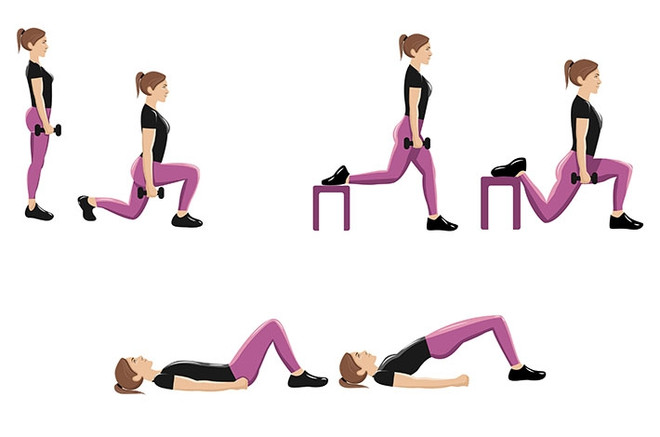
Be careful or even refrain if you have knee injuries or other pathological conditions. If you experience pain or discomfort while performing the Bulgarian lunges, try starting with regular classic lunges with your leg on the floor behind you. If the discomfort persists, the Bulgarian lunges are not for you.
Combine them with a series of core exercises
Because lunges work the lower body, it's a good idea to include them in your routine on days when these muscle groups are most heavily used. You can incorporate them into a leg training day, or into a full body workout that works all muscle groups in one session. For advanced athletes, Bulgarian lunges can be part of circuit training.
Light Bulgarian lunges can be used before a basic leg workout or as a 'final' exercise, for example after heavy squats or leg presses. You can safely do the balance exercises 2-4 times a week.
In general, split squats are not an exercise for beginners. They are inserted into the training process when you need to get to the next level and increase the load. Don't force the process, give yourself time to master the right technique and then you won't have to wait long for results.
Read more:- muscles in the legs.
- Exercises for the triceps tibialis muscle.
- lower leg muscles.
- Anterior tilting of the pelvis.
- Which muscle extends the lower leg and flexes the thigh.
- muscle work while running.
- lower leg stretches.
- Square soleus muscle.
